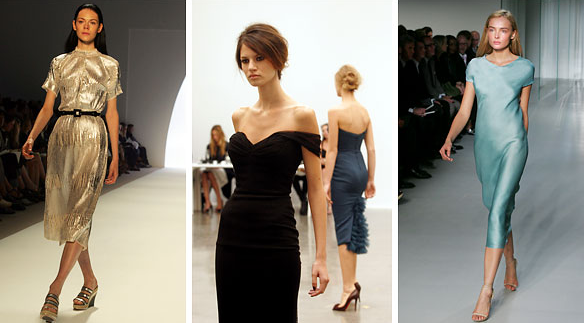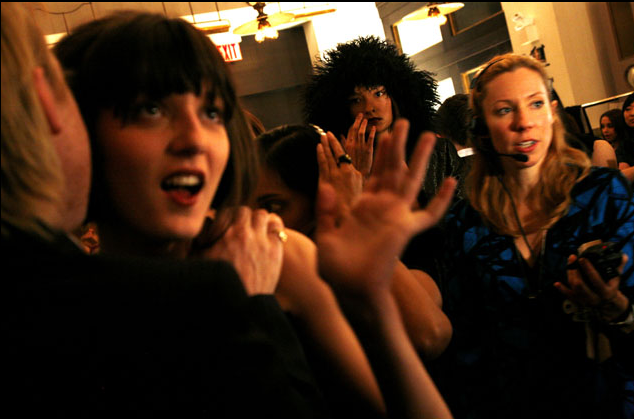It’s been Fashion Week in the papers more than once this fall. Milan, Paris, London, New York, and even Chicago had shows providing a ready supply of exotic creations, otherworldly spectacles, and wretched excess. And then there were the clothes.
You don’t have to look too long to see that most of the images fall into a very few genres, and that photojournalism is providing free publicity for the industry. For example, Elle on line features Runway, Detail, and Backstage photos–all equally posed–and news coverage often will give you one or more of each.
That doesn’t mean that the photojournalists don’t inflect what they see. It isn’t hard to do, but they nonetheless should be given some credit for emphasizing the incredible lifelessness of the models. This is done in several ways, including showing a line of models that look like clones, and showing backstage shots suggesting that the completely passivity and vacuousness seen on the runway is not a pose. I’m sorry that I’ve misplaced some of the better images to make the point, but look at this triptych from the New York Times:
The two outer panels show us the clones. Despite different hair color and dresses, the two models have equally blank expressions and nearly identical bodies and walks. One can look very closely and identify many small differences, of course, but the effect of the pairing is to push the viewer in the opposite direction: they could just as well be the same model. That, of course, is the point of the exhibition, which is to feature the dress and not the person inside.
The middle panel provides the backstage shot. It could be used for a party quiz: is the women in the foreground alive or a mannequin, or perhaps one of the next generation of Stepford Wives? Again, you might be able to peer into her face and see great depth; readers of Russian literature are welcome to the challenge. It is more likely that the image, like those on either side of it, suggests that the vacuum-like isolation surrounding each model is matched by a vast interior silence.
I think these portraits of the models may be a gender-comprehensive protective mechanism: Just as most of us aren’t going to wear high-fashion apparel most of the time, if at all, we really wouldn’t want to be one of those anorexic dopeheads, or marry one. That fantasy comes at a cost, however, for it carries with it the idea that fashion is but the inert material that we use to drape our bodies and decorate an impersonal world. That’s true enough some of the time–and a good thing, too–but it can lead to highly misleading conclusions about what it means to be normal, reasonable, or human.
To get a sense of what is missing, look at this image:
Taken by Patrick Andrade, it’s only caption is “Fashion Week.” Another backstage shot, this one is anything but posed. The image is pulsating with social energy. Those in the picture are crowded together yet gesticulating and talking avidly. The brunette on the left seems to be exclaiming about someone off camera while the guy with his hands on her shoulders seems to be trying, not very well, to calm her down. The blond on the right talks not only to those around her but into her miked headset. This scene features the handlers who are frenetically managing the show and perhaps for that more like you and me. But it’s really not about this or that occupational role. Those in the scene crowd up against the viewer as if we were at a party. The background could be any office or apartment, and the off-kilter angle and lurid lighting reminds me of more than one great night out.
What makes the image even richer is that it still includes the conventional model, in this case the brunette with the bone structure, exotic hair, and glazed look in the background. Again, she could be what you’d expect at good party: is that a wig? Is she a he in drag? What’s he on? She does seem to be pretty stoned, and the gesture of her hand looks more like the involuntary tic of serious coke habit. We still get to dish on the models, but now they’re just one part of the social scene and well in the background.
The point is not who gets the fashion world right. This photo has captured something much deeper: how fashion is one expression of the ferocious energies unleashed by our being social animals.
Photographs by Hiroko Masuike, Erin Balano, Hiroko Masuike for the New York Times; Patrick Andrade, http://www.patrickandrade.com/


[…] image was used to decorate a puff piece on the current fashion for red lipstick.I’ve posted before about how fashion carries the enormous energies released by our being social animals. This image is […]